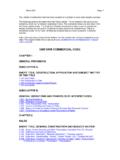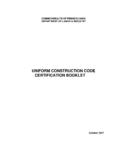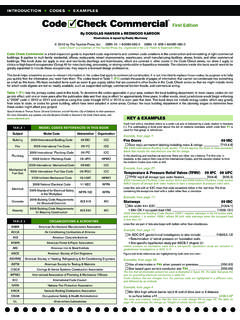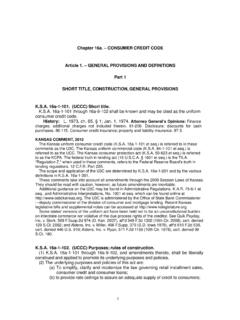Transcription of WHAT IS A COMMERCIALLY REASONABLE SECURITY …
1 C. David Hailey is a partner with Mozley, Finlayson & Loggins LLP in Atlanta, Georgia. The author gratefully acknowledges the assistance of Bridgette E. Eckerson, an associate with the firm. 95 what IS A COMMERCIALLY REASONABLE SECURITY PROCEDURE UNDER ARTICLE 4A OF THE UNIFORM COMMERCIAL CODE? C. David Hailey I. INTRODUCTION Every minute of every day, cybercriminals are at work.
2 The criminal might be looking for confidential personal information that can be used for identity theft or other criminal activity. Other times the criminal might be trying to gain access to a company s online banking information. Once the criminal gains access to a bank customer s username and password, the criminal may be able to electronically transfer the bank customer s money to an account maintained by the criminal and abscond with the funds.
3 Electronic transfers are virtually instantaneous. Once the money is released from the bank customer s account the crime is almost always complete. The odds of recovering the funds once they are transferred are negligible. When a fraudulent electronic transfer occurs, questions arise regarding liability for the loss. The unsuspecting bank customer immediately blames the bank and demands that the bank replace the funds. From the bank customer s perspective, the electronic transfer was not authorized and thus was improper.
4 The customer feels that the unauthorized wire transfer should be treated just like a forged check and the bank should be liable. Predictably, the bank s view of its liability differs from the bank customer s view. From the bank s perspective, it did nothing wrong. The criminal in most instances gained access to the bank customer s online banking information through the bank customer s computer system, usually by the use of some form of malware. The bank had a SECURITY 96 Fidelity Law Journal, Vol.
5 XXI, November 2015 system in place that guarded against fraudulent wire transfers without being unduly burdensome on the bank customer. The bank feels that the customer has an obligation to protect its online bank credentials from computer predators. As noted in a recent decision in this area, the tension in modern society between SECURITY and convenience is on full display in disputes of this Liability for fraudulent wire transfers is an important consideration in many fidelity bond claims.
6 The bank may have coverage under its financial institution bond for fraudulent wire transfers from a bank customer s account. However, as will be discussed in this article, the bank may not be liable for the unauthorized activity. Similarly, the bank customer may have coverage for fraudulent wire transfers under its commercial fidelity bond. But if the bank ultimately is liable for the fraud, the bank customer s fidelity carrier may have a subrogation claim against the insured s bank.
7 The respective obligations and potential liability of the bank and the bank s customer for losses due to fraudulent electronic transfers is the subject of Article 4A of the Uniform Commercial Article 4A aims to provide a uniform set of rules to govern the electronic transfer of funds, rather than an exchange of currency or payment by When a fraudulent funds transfer occurs, the receiving bank often will deny Generally, the bank s denial of liability will be based on the bank s belief that it has a COMMERCIALLY REASONABLE SECURITY procedure in place which, under Article 4A, provides the bank with protection if all the requirements are met.
8 1 Choice Escrow & Land Title, LLC v. BancorpSouth Bank, No. 10-03531-CV-S-JTM, 2013 Dist. LEXIS 36746, at *25 ( Mo. Mar. 18, 2013), aff d in part, rev d in part, and remanded by 754 611 (8th Cir 2014). 2 4A-101 to -507 (2015). 3 4A-102 & official cmt. (2015). 4 Like all sections of the UCC, Article 4A has its own terminology. The person who initiates the funds transfer, usually a bank customer, is referred to as the sender.
9 4A-103(a)(5) (2015). The wire transfer instructions that the sender gives to its bank are referred to as payment orders. Id. 4A-103(a)(1). The sender s bank is referred to as the receiving bank, because it receives the payment orders. Id. 4A-103(a)(3). what is a COMMERCIALLY REASONABLE SECURITY Procedure 97 This article will explore the receiving bank s ability under Article 4A to avoid liability for a fraudulent payment order if it has a COMMERCIALLY REASONABLE SECURITY procedure in place.
10 Of necessity, this article will discuss the related issues of whether the particular SECURITY measures the bank has in place constitute a SECURITY procedure, and whether the sender and the receiving bank agreed to the SECURITY procedure. As part of this discussion, this article will consider the impact of the guidance published by Federal Financial Institutions Examination Council ( FFIEC ) in 2005 and then supplemented in This article will also discuss the interplay between the bank s obligation to have a COMMERCIALLY REASONABLE SECURITY system in place and the bank s obligation under Article 4A to act in good faith.








